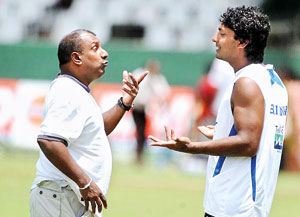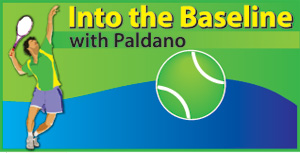‘Trump cards’ of Cross-Training
View(s):Regardless which sport it is, ‘All-Rounder’s perform the best. It means sportspersons who do multiple sports opposed to those focused only onto a single discipline. Most of our top notch players in the past were well known to have been involved in more than one sport during development. It developed in them the skills, physical abilities, excellent reaction base and above all the lateral thinking when it came to tactics and strategy. One never knew from which book of tactics they pulled out the winning tactic.

In the past, cricketers such as Kumar Sangakkara and Aravinda de Silva played good tennis
This idea is not abandoned in the world but just that the notion has gone underground in many countries. This is a disadvantage that we face today. A Tennis player playing other sports will have to use a different line of thought, readiness and reaction, skills and adaptations. It makes them use different parts of the brain to succeed. This practice will be of great benefit when they play Tennis especially when they are up against a tough opponent. This is one of the main advantages of Cross-Training- the adoptability factor.
Flexible Cross-Training
Cross-Training is the expression that is commonly used to express the old idea of doing many sports. It is now a section of sports study which is very much emphasized in developed countries. For example, Field Hockey is considered the Partner-Sport of Tennis. If one had a chance to go past our sports clubs in the mornings, they would see National Cricketers playing improvised Football, Touch Rugby and occasionally even Volleyball. The foreign cricket coaches we have had were educated in this way. Cross-Training is even known to have a relaxation effect on the body.
In early years of development, players who do Tennis only had the good possibility of becoming a ‘drop-out’ than those who do a few sports simultaneously. The way Tennis is taught now is too rigid and it seems to have only one aim that is to get most out of the ‘court’ than from the ‘players’. Sometimes there are more than ten players at a time on court. What more in such situations players are into an eternal training of ‘forehand and backhand’, which is extremely closed and monastic in discipline and it does not have the fun and flair of sports. Children cannot sustain it for long. Tennis is an open-sport. Learning and training for it in any other form will not be the best.
Partner-sport concept
In the past most of the Cricketers played good Tennis, especially doubles. Former Sri Lanka Cricket captains C.I. Gunasekera, Michael Tissera, Aravinda de Silva and Kumar Sangakkara are very good examples. P.S. Kumara was an excellent Squash, Hockey and Cricket player and Arjun Fernando was a good cricketer. In Tennis the challenge is not ‘lineal’ but multifaceted. In such a situation the knowledge and the ability of other sports is one of the best preparation for competition.
The idea of Partner-Sport came to being to make all aspects of development interesting and move away from dull repetitive discipline. The competition calendar has seasons and off season and also weather patterns. Partner-Sport concept has many advantages to keep evolving during these times.
The way to go ‘far’ in Tennis is to find out partner sports which would contribute to the interesting and fun filled path in development. For Tennis preparation, 200 metre sprint in athletics gives the muscular and aerobic development needed. Hockey gives good equipment handling ability and the critical eye for the ball. Squash gives agility and skill improvisation. Football and Basket-ball being more of a body contact game develops good physical balance. Cycling is again for balance and to increase aerobic capacity. Improvised versions of these games are recommended as these games can induce physical injuries in total form. All the same if this is not possible it is good to indulge in full fledged game than not to.
 Doubles as alternative
Doubles as alternative
In Tennis today only singles seem to matter. In the professional calendar there is a strong aversion to include doubles in the list of events by the organizers. When the hard courts came into being, the game of Doubles which has shorter rallies became super short. It made the game unattractive to spectators. This is the cause of organizer’s aversion. This trend has been noticed and now there is a revival of the game of doubles with changes in playing formats. It is interesting to play doubles as it has challenges not present in Singles.
Surprise is the strongest tactic in the game of doubles. Choking the opponents with speed, positioning to cover court to restrict opponents shot selection and others have significant tactical value in doubles and have its use in Singles too. In this sense, Doubles should be the first line of choice in the idea of cross-training for every player.
In development everyone looks for the magic but there is no such thing. Players should arrange the annual calendar effectively with the plans for the off-season. The alternatives, such as the Cross-Training and partner sport can be used for beneficial effects. Often the possibilities are at the door step. We only need some lateral thinking! This has to be another of the player responsibility that must be included to develop if anyone out there is interested to be a Top-Gun.
-George Paldano, Former intl. player; Accredited Coach of Germany; National, Davis-Cup,
Federation Cup captain/coach–
georgepaldano@yahoo.com


